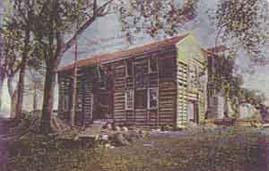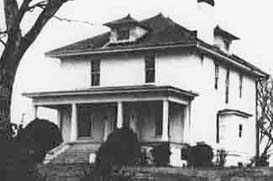 |
||
|
||
| In 1790, he settled on a 280 acre farm in the valley which was later named after him, and built a large two story log cabin. Here he lived with his two wives. The first was Emily Stanfield Meigs, daughter of Timothy Meigs and granddaugther of Col. Return Jonathan Meigs, the noted Indian Agent for the U.S. government. His second wife was an Indian woman named Nancy who was the daughter of the Rev. Jesse Bushyhead, a famous minister and leader of the Cherokee Indians. |
 |
|
In 1825, while serving as a "civil officer" and working with John Sheppard, Walker helped seize and confiscate 18 barrels of unlicensed whiskey and two barrels of peach brandy without a legal warrant. The offended party was of the opinion that "the only good Indian was a dead Indian" and plotted his revenge for nearly ten years. Walker was ambushed and killed by James Foreman as he rode home from a council meeting at Red Clay in August 1834. Walker was buried in the northeast corner of the orchard on his farm, not far behind the cabin. His wife, Emily and her children continued to live on the farm for sometime until moving into downtown Cleveland. The murder trial, which was held in McMinn County, was one of the most notable criminal cases in early Tennessee history. The official Tennessee Supreme Court record takes up 114 pages of volume 16 of the official reports of that court. Somehow, Foreman managed to escape punishment and made his way to Oklahoma, where he was later killed by Stand Watie in an apparent act of revenge for the killing of Chief Walker. |
||
The War Between the States brought heavy fighting in the area of Cleveland, Chattanooga and Lookout Mountain as the Union forces battled their way to Atlanta. In 1865 the county court house and other buildings in the town of Cleveland were burned to the ground. All records were lost. Little is known of who owned the Walker Farm during this time. But the old log cabin which Walker built was still standing in 1890. According to the historian of the Ocoee Chapter of the DAR, George Fain pulled down the neglected old cabin in 1907 and built a "commodious residence" on the same spot where the cabin had stood. Fain sold the logs from the cabin to a man named Muchler or Mullins (no one is really sure) who built a house and barn from them. |
||
 |
The new house had fireplaces on the first and second floors, and a large basement containing a coal-burning boiler which provided steam for radiators in every room. The floor of the basement was concrete with an underground drainage system which ran out to the road in front of the house. Behind the house was a two story smokehouse and an orchard, and in front of the house, a wide curving driveway with a walk up to the front porch. It was indeed a "commodious residence." |
|
History | Memories Album | Recipes | CFI Industries |
||
cfi ©2000-2011 | Contact the Webmaster |
||